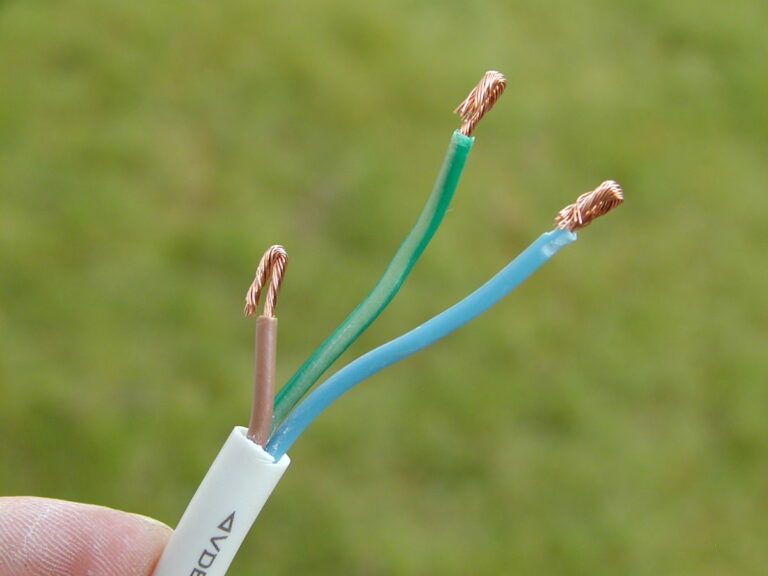The earth wire, also known as the grounding wire, plays a crucial role in electrical systems, providing a safe path for electrical current to ground in case of faults or electrical surges. Its distinct color is a safety measure established in many countries to easily identify and differentiate it from other wires within electrical circuits. The color convention for the earth wire is a combination of green and yellow stripes.
Furthermore, this standardized color scheme helps electricians and individuals working with electrical appliances or wiring to correctly identify, connect, and ensure the safety of the grounding system, preventing electric shocks and minimizing the risk of electrical hazards in homes, buildings, and various electrical installations.
What is the role of the earth wire in electrical systems?

The earth wire, also known as the ground wire or protective earth (PE) wire, plays a crucial role in electrical systems by providing a safe path for current to flow to the ground in case of a fault or electrical leakage. Its primary purposes include:
Safety
The earth wire acts as a safety measure to prevent electric shocks and protect individuals from potential electrocution. In case of a fault where the live wire comes in contact with an exposed metal surface (such as an appliance casing), the earth wire provides a low-resistance path for the current to flow directly to the ground, tripping the circuit breaker or fuse and preventing harm to anyone who might touch the metal surface.
Equipment Protection
It helps to safeguard electrical appliances and devices from damage due to surges or faults. By providing a path to ground for excess current, the earth wire prevents damage to sensitive equipment and ensures that excessive voltage doesn’t reach and harm the appliances.
System Stability
The earth wire also aids in stabilizing the electrical system by maintaining a reference voltage level. It helps to prevent fluctuations and interference that could disrupt the normal functioning of electrical equipment.
How is the earth wire color standardized and identified?
The color coding and identification of electrical wiring, including the earth wire, can vary depending on the country or region and the specific wiring standards followed. However, several general conventions and standards exist to help identify the earth wire:
International Standards
In many countries, the color green and yellow stripes are commonly used for the earth wire. This combination of colors helps distinguish the earth wire from other wires in an electrical installation. For instance, it might be a solid green and yellow striped wire or have green and yellow insulation.
Regional Standards
Different regions may have their own standards for wire color coding. For instance:
- In the United States and Canada, the earth wire is typically identified by a green or bare copper conductor. It may also have yellow and green stripes.
- In some European countries following the IEC (International Electrotechnical Commission) standards, the green and yellow color scheme is prevalent for the earth wire.
- In the United Kingdom, the standard colors are green and yellow for the earth wire.
Labeling and Markings
Sometimes, if the wire insulation color doesn’t strictly adhere to the color standards, electrical cables or wires might have markings or labels imprinted along the length of the wire to indicate that it is the earth wire.
Moreover, these markings may include symbols, letters (such as “PE” for Protective Earth), or stripes in the specified colors.
What safety precautions does distinguishing earth wire color ensure?
Distinguishing the earth wire color serves several important safety purposes in electrical systems.
Prevention of Electric Shocks
The distinct color coding, such as green and yellow stripes, helps electricians and individuals identify the earth wire easily during installations, repairs, or maintenance work. This identification ensures that the earth wire is correctly connected to the grounding system. When properly connected, it provides a low-resistance path for fault currents to flow to the ground, preventing electric shocks in case of faults.
Correct Wiring and Connections
Using standardized colors for the earth wire helps ensure that it is correctly identified and connected to the appropriate terminals in electrical outlets, plugs, and appliances. This prevents accidental interconnection with live or neutral wires, reducing the risk of electric shock or fire hazards due to incorrect wiring.
Maintenance and Repairs
Proper identification of the earth wire simplifies maintenance and troubleshooting tasks. Electricians and maintenance personnel can quickly locate and work on the grounding system or address any issues related to the earth wire without confusion.
It streamlines the process of ensuring the integrity of the grounding system, which is critical for electrical safety.
Compliance with Electrical Codes
Electrical codes and regulations in various countries mandate the use of specific colors for different wires, including the earth wire. Adhering to these color-coding standards ensures compliance with safety regulations and standards, promoting a safer electrical environment for both professionals and end-users.
How do different countries comply with earth wire color conventions?

Different countries have varying electrical standards and regulations, including those concerning wire color conventions, including the color coding for the earth wire. Compliance with these conventions is typically enforced through national or regional electrical codes and standards. Here’s how different countries tend to comply with earth wire color conventions:
United States and Canada
In the United States and Canada, the color coding convention for the earth wire (grounding conductor) commonly involves using a solid or striped green insulation or bare copper conductor. This green color indicates the grounding or earth wire in electrical wiring systems.
European Countries
European countries often follow the IEC (International Electrotechnical Commission) standards, which prescribe green and yellow stripes for the earth wire. This color combination makes it easy to identify the earth wire within electrical installations.
United Kingdom
The UK adheres to its specific wiring color standards known as BS 7671 (IET Wiring Regulations). In this system, the earth wire is distinguished by green and yellow stripes or a solid green and yellow color for identification purposes.
Other Regions
Other countries and regions might adopt variations or adaptations of these standards. Some may align closely with the IEC standards, while others might have their own nationally recognized codes specifying earth wire color conventions.
While many countries have established specific color conventions for the earth wire, it’s essential to note that these conventions might change or have variations based on updates to electrical codes and regulations. Furthermore, some countries might adopt international standards while modifying or incorporating these standards into their national codes according to local practices and needs.
FAQ’s
What color is the wire in a 3 plug?
The wire colors in a three-pin plug can vary depending on the country’s electrical standards. Common colors might include brown (live), blue (neutral), and green/yellow (earth) in some regions.
What color is neutral and earth wire?
Neutral wire color can be blue in some wiring systems, while the earth wire typically has green and yellow stripes or solid green insulation in various electrical installations.
What are the 3 wires in a plug?
The three wires in a plug are usually live, neutral, and earth. Live wires can be brown, red, or black; neutral wires are commonly blue; earth wires are green/yellow.
How do you wire a 3 wire plug?
The brown (live) wire connects to the fuse, the blue (neutral) wire attaches to the neutral terminal, and the green/yellow (earth) wire connects to the earth terminal within the plug’s configuration.
What color is neutral wire?
Neutral wires are typically colored blue in various electrical wiring systems.
Which wire is positive?
In electrical wiring, particularly in AC (alternating current) systems, wires are not designated as positive or negative like in DC (direct current). The live wire (often brown) is considered the primary conductor for electrical power in AC systems.
Final Words
In conclusion, understanding the color of the earth wire in a plug is crucial for safety in electrical systems. The earth wire, often colored with green and yellow stripes, serves an important purpose by providing a safe pathway for electrical currents in case of faults or surges. This color standardization ensures that it’s easily distinguishable from live and neutral wires, preventing potential electric shocks and hazards.
By adhering to these color conventions, people worldwide can correctly identify and connect the earth wire during electrical installations, contributing to a safer environment in homes, buildings, and various electrical setups.

